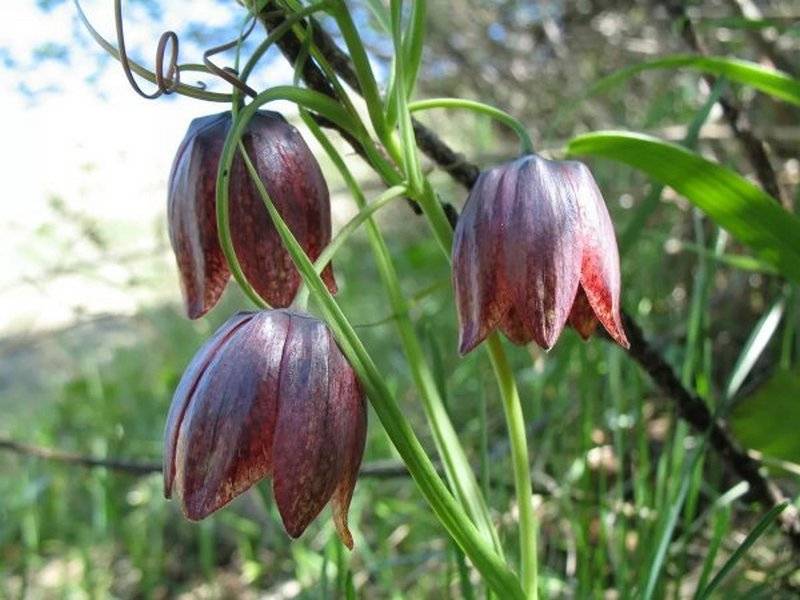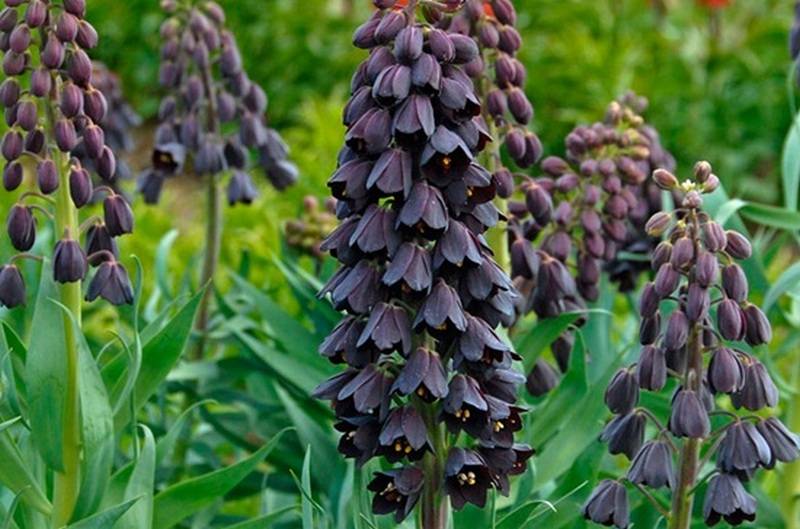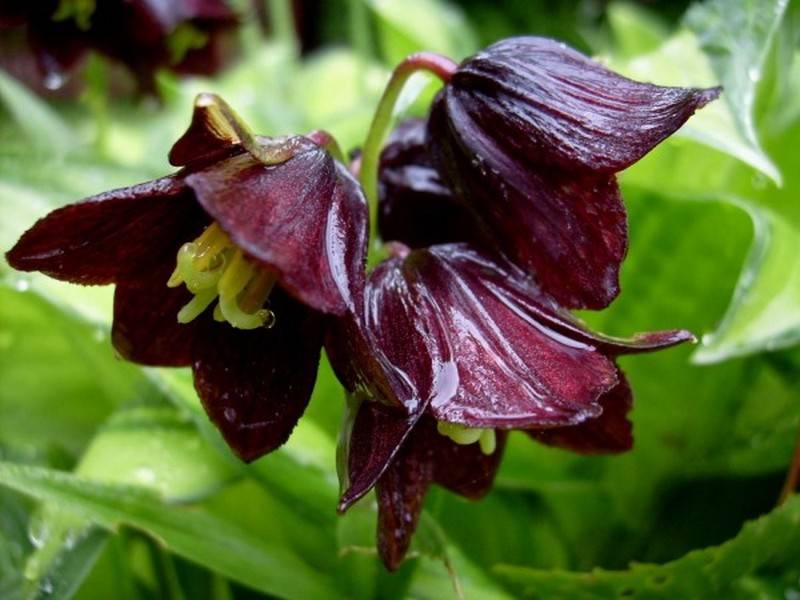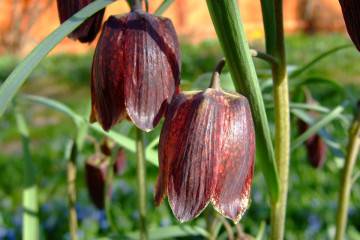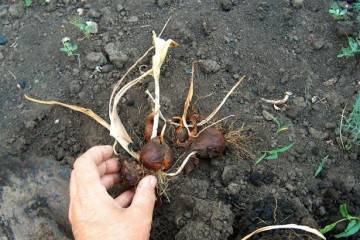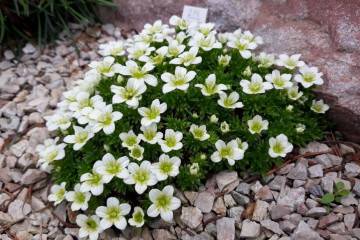Grouse flower: planting and care after flowering
Content:
Grouse is an ordinary perennial plant from the Liliaceae family, which is considered the most beautiful spring flower. Flowering begins in late April - early May. Its name is translated from the Latin "Fritilus" "fritillaria", which means "chessboard", "vessel for dice." And it is named so because the shape of the bud really looks like a vessel or glass. Hazel grouse is a flower that goes well with tulips, you just can't take your eyes off their tandem. Below is a detailed description of the hazel grouse flower, its planting and care in the future.
Description of hazel grouse
Grouse is a perennial plant, tolerates severe winters well, propagates by seeds and bulbs. The bulb itself is covered with fleshy scales that have grown together. If there is no accretion, then new bulbs begin to develop in the sinuses. Oblong-lanceolate leaves are whorled or chaotic on the stem.
Grouse imperial
The imperial hazel grouse is considered the largest representative of the genus and belongs to the petilium group.
The plant can reach a height of 1.5 m.At the very top of a powerful peduncle there is a crown consisting of pointed leaves 10 × 20 cm.
For your information! Huge flowers with a diameter of 7 cm bloom under the crown. The shape of the inflorescences resembles the shades of a chandelier. At the very beginning, drooping flowers look down, then they gradually raise their petals up.
The best varieties of imperial hazel grouse:
- Rubra is an interesting variety with red flowers. The stem reaches only 60 cm in height;
- Prolifera is a favorite variety. The flowers are golden orange;
- Sulferino. Red veins run along the entire surface of the orange petals.
Imperial hazel grouses are flowers that are unpretentious to care for, Turkey is considered their homeland. They bloom very early, giving bright colors to the wilted garden. The plant is resistant to spring frosts.
Russian hazel grouse
The stem height varies from variety and is 15-70 cm. Thin leaves have a spirally twisted top. A rare species that is under protection. The color of the flowers can vary from maroon to brown.
The population decline was due to the fact that people began to massively dig up its bulbs and transfer them to their garden.
Chess (variegated)
This is perhaps the most amazing view. The petals of its flowers are strikingly mottled with multi-colored specks in the shape of a square. These specks are staggered along the surface of the sheet, hence the name. The plant reaches a height of 20-40 cm.
On one plant, only one inflorescence blooms with flowers of a violet-brown tone. The most common varieties of variegated hazel grouse: Aphrodite, Mars, Jupiter.
Grouse Mikhailovsky
The stem of a low plant reaches 20 cm. In natural nature, it is widespread in Turkey. Single flowers bloom on each plant of Mikhailovsky hazel grouse. Each of the burgundy petals with a beautiful yellow border.
Persian hazel grouse
What is Persian Grouse? The exotic plant came from Israel. Persian hazel grouse is a tall representative of the species. Its stem can be up to 100 cm long.In the pyramidal inflorescence, there are up to 30 flowers, painted in bright purple color. In shape, the flowers resemble miniature bells. In addition to the purple color, there are varieties with variegated, pale green and creamy petals.
Grouse Edward
A vigorous, tall plant with an erect stem. The inflorescences are located at the very top and are in the shape of an umbrella. Large bell-shaped flowers are colored orange, they look in different directions.
Kamchatka hazel grouse
The stem of the undersized representative grows only up to 60 cm. The peculiarity of the species is the yellowing of the foliage immediately after flowering. The beautiful flowers are purple or dark bronze colored. The pharynx is bright, a chess pattern is barely noticeable on the petals. Flowering occurs in early June or the last decade of May, it all depends on climatic conditions. The peak of flowering occurs in the middle of the month. Propagated by bulbs.
For your information! A feature of the species is the unpleasant smell of flowers, which attracts insects, so nature took care that the plant could pollinate flies.
Grouse in landscape design: the best flowerbed partners
The broadleaf hazel grouse fits perfectly into the landscape design in the form of group plantings on the lawn. Grouse checkerboard white is suitable for planting near water bodies.
If you want to make mixed plantings, then daffodils and tulips can be chosen as companions. Faded hazel grouses have an unattractive appearance, therefore, to hide their wilting, irises can be planted side by side. Since flowering in these plants occurs much later, they cover the hazel grouse with the beauty of their inflorescences.
But group plantings are considered the most optimal. The royal flower is ideal in joint plantings with heiranthus, daffodils and tulips.
If the hazel grouse is properly planted and looked after, then even an inexperienced gardener can grow a beautiful fritillaria plant, worthy of attention.
Does hazel grouse help from moles in the garden
Quite a controversial issue. It is known that hazel grouse bulbs, as well as ornamental onion bulbs, have an unpleasant odor. Daffodil bulbs are generally considered poisonous.
It was these characteristics of the plants that prompted gardeners to think that if they plant these plants around the perimeter of the flower bed, then such a planting will protect against the invasion of moles, and also scare off other rodents. However, this method does not always work.
Breeding methods for hazel grouse
The royal plant reproduces in only 2 ways: by seed and vegetatively.
Seed reproduction
All types of exotic plants can be propagated by seeds. Rules for collecting seeds and preparing them for sowing:
- the collection of seeds is carried out only after the capsule is completely dry. It is recommended to sow freshly harvested seeds immediately, since they have a short shelf life;
- you need to sow immediately to a permanent place. Seedlings need feeding;
- seeds must be embedded in the soil to a depth of 1 cm;
- autumn sowing is carried out in rows, the distance between which is 10 cm. It is recommended to cover the sown seeds with a layer of peat;
- the first shoots can be observed next spring;
- digging out the seedling bulbs is possible only 2 years after their development. Storage is carried out in a dry place.
If varieties that are resistant to moisture are grown from seeds, then in one place they can grow for 4 years, until the onset of flowering. Then they can be seated.
Reproduction vegetatively
Several substitutes can be created from one exotic onion. The bulbs of many species of hazel grouse grow in size during the growing season, and small baby bulbs are formed along their edges.They will have to be grown to get full flowering.
The small bulbs can be easily separated from the mother plant. The whole procedure is carried out during the excavation of the planting material.
In addition, many gardeners practice the artificial division of the mother's bulb. To do this, you need to break the onion and dry the resulting parts. Planting must be carried out much earlier than the rest of the bulbs, since the separated ones are less resistant to drying.
How to plant and grow hazel grouse flowers
Planting of decorative hazel grouses is carried out in compliance with some agrotechnical techniques.
- Timing for boarding. It is recommended to plant the bulbs at the end of September. Late transplanting may result in no flowering.
- Illumination. The plant prefers open sunny areas or sparse shade.
- Good planting material. Healthy bulbs are the key to successful growing.
- Preliminary processing. Before planting, the bulbs should be treated from microorganisms by soaking in a weak solution of potassium permanganate.
- Drainage. The hazel grouse does not tolerate stagnant water, therefore, it is necessary to arrange drainage at the bottom of the hole.
- Planting depth and soil. The choice of parameters is influenced by the bulb size and appearance. It is better to take fertile air and moisture permeable soil.
When planting, it is important to respect the distance between the bulbs.
Important! If it was not possible to plant the purchased planting material, the bulbs are stored on the lower shelf of the refrigerator. Store in paper bags.
Bulb selection
In order for the cultivation and care of hazel grouses to bring maximum satisfaction, you need to know how to choose the right planting material.
The bulb is shaped like a flat ball with a through hole. The weight of one varies between 0.5-1 kg. When buying, it is important to pay attention to the surface of the planting material. The bulb should be free of visible damage, and there should be no soft areas. On the bulb, pruning of last year's stem and dry roots are allowed, which should not be removed.
Care for hazel grouses after flowering
How to care for hazel grouse flowers? Many gardeners do not know what to do with the decorative hazel grouse after flowering. Due to the fact that exotics are representatives of the Liliaceae family, the care for them should be appropriate.
Caring for hazel grouse after flowering is the implementation of proper watering. The number of procedures should be 1-2 per month.
In addition to the application of fertilizers, which are carried out at the beginning of the growing season, it is also necessary to feed the exotics after flowering. Peat, humus, complex mineral fertilizers need to be added to the soil.
What to do with the imperial hazel grouse after flowering? It is recommended to cut off the aerial part immediately after flowering.
For fritillaria to bloom next year, you need to dig up the bulbs in June. It is allowed to carry out the procedure once every 2 years, and not annually. Such a condition is necessary for lush flowering. In addition, the procedure is carried out to exclude shrinking of the variety's bulbs.
Note! Digging is carried out at a time when the leaves begin to dry out. All work must be carried out in good sunny weather.
Digging is carried out with a shovel. After that, you need to carefully remove the bulb from the ground so as not to damage it.
If an onion is accidentally cut during digging, it does not matter. It should not be thrown away. Such bulbs give children well. Therefore, the cut material must also be sent to dry.
After digging, it is recommended to clean the bulbs from dried scales and disinfect in a weak solution of manganese acidic potassium.
After that, it is necessary to inspect the planting material and cut out the spots. These places need to be sprinkled with activated carbon. Next, the bulbs are sent to boxes, which are placed in a well-ventilated area to heal the wounds.
The optimum storage temperature is 23-25 ° C.Store in a ventilated area until roots appear. During storage, you need to inspect the material, remove rotten bulbs in time so as not to infect the rest.
Diseases and pests
If it is noticed that the foliage and stems begin to fade ahead of time, it is possible that the flower has become sick with rust. You can understand that the plant is sick with a close examination of the inside of the leaf. In case of disease, on the underside of the plate there are fungal spores located in powdery pustules, colored brown.
With a strong spread of the disease in a flower bed, it is recommended to treat topaz, phytosporin with fungicidal preparations.
In order to prevent the appearance of an ailment, it is necessary to observe preventive measures: regularly remove the remnants of faded plants, grass, and carry out constant mulching of the soil. To reduce the risk, you need to feed the plantings with phosphorus-potassium fertilizers.
Sclerotinosis is another insidious disease. It manifests itself in the form of wilting of the tops and rotting of a part of the stem at the base. On examination, the lower leaves of the flower are transparent, watery, the plate is covered with a bloom of white. The stem may be covered with black blotches.
The disease develops in the soil due to the penetration of the pathogen. Then the bulbs become infected. When viewed, their surface can also be covered with a white coating. Black sclerotia can also be seen. The disease is insidious because the pathogen is in the soil for 5 years.
Note!If it is not possible to cure the disease, all plants should be destroyed, and the soil should be sprinkled with lime or shed with bleach.
Sometimes, when storing the bulbs, you may notice wet spots that sink into the tissue itself. It was the fusarum mushroom that damaged the bulbs. All damaged material should be destroyed, the remaining bulbs should be treated with a solution of the fludioxonil drug and planted on the site.
Among gardeners, hazel grouse is considered a royal flower. The motley view of group landings is simply mesmerizing. The imperial hazel grouse is resistant to many diseases, it is only necessary to properly care for it, dig up the bulbs in time and prevent the planting material from freezing. With royal flowers and the garden area will look great.

